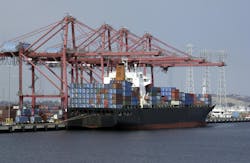Tips for Manufacturers to Prepare for President Trump's Trade Policies
On January 20, 2025, Donald J. Trump will be inaugurated as the 47th president of the United States. During his presidential campaign, he suggested several trade policy shifts that he intends to implement. President-elect Trump’s trade policies may directly or indirectly impact most industry sectors, for example, including consumer products, technology, industrials, agriculture, and life sciences.
During the last few years, U.S. and non-U.S. companies have been vigorously evolving their strategies, operating models, and supply chains in response to many disruptive forces, including COVID, military conflicts, and other geopolitical and macro-economic factors. The incoming administration’s policies are now forcing U.S. and non-U.S. companies to reexamine the efficiency and resiliency of these recently developed strategies and supply chains.
President-elect Trump talked about a lot of different aspects of trade policy. Although he can initiate actions unilaterally on “Day One,” others may take time and require congressional interaction. As policies start to solidify, companies should consider assessing their current position, risks, future opportunities, and develop a comprehensive cross-functional plan to respond to the impending change.
What May the New President Do?
A U.S. president has many tools available to implement trade policy, for example:
- Tariff authority (e.g., Section 301)
- Executive orders
- Sanctions and embargoes (e.g., International Emergency Economic Powers (IEEPA))
- Trade Agreement negotiation
- Trade Promotion Authority ("fast track" authority)
- Trade enforcement (e.g., US Trade Representative, Bureau of Industry and Security)
Some of these can be executed as what is commonly referred to as “day one actions” (e.g., IEEPA, executive orders); while others require some level of congressional involvement (e.g., trade agreement negotiation, fast track authority) and could take significantly longer to implement.
How Will Companies React?
Companies are exploring or already taking active steps in preparation for the new administration’s potential tariffs and trade policies. Each option has pros and con and not all options are available to all companies.
A few options being considered for immediate action include:
- Increasing (“pre-loading”) Inventory: To avoid the immediate impact of tariffs, some companies may increase their inventory levels by purchasing goods before the tariffs take effect. This may help to mitigate the tariff impact, but it will increase inventory holding costs and potentially increase logistics costs. In some cases, it may increase the pressure on forecasting and the risk that the extra inventory cannot be sold. Depending on the item, for example perishable inventory, may suffer damage or loss.
Practically speaking, there is a question on how much inventory a company can front load based on cycle time from order through production to delivery into the United States. Remember that tariffs are applied upon importation of goods. So, prepayment without delivery does not solve the problem. Foreign Trade Zones (Zones) can be considered for duty deferral, but due to current Section 301 treatment of Zone admissions, companies would be well advised to import those products from the Zone in advance of any new tariffs.
From a tax perspective, holding more inventory longer than usual may change the profile of a related limited risk distributor; thus, may increase the compensation it earns.
- Relocating Production: Some companies are considering relocating manufacturing operations to countries that they believe will not be affected by the tariffs. It may be obvious which countries are clearly in the incoming administration’s sights. Without final authority in place, however, it is difficult to definitively know which countries may be outside the scope of the new policies.
Buying or building a new facility is expensive and operationally disruptive. By contrast, reallocating capacity between existing facilities may mitigate costs and disruption if the “receiving facility” has capacity and appropriate production lines. Another option is to hire third-party contact manufacturers to produce goods. Even if the third-party contract manufacturers are already on board, the shift may not be as simple as it sounds. For example, one must address supply contracts, raw material vendor alignment, customs processes, order management.
- Passing Costs to Consumers: In some cases, companies may pass the increased costs due to tariffs onto consumers by raising prices on their products. Would doing so put them in a competitive disadvantage. In the context of B-2-B sales, do contract terms and conditions all for the price increase? If they choose not to pass some or all of the additional costs to customers, then companies may have to consider cutting costs elsewhere in the organization.
- Customs valuation planning: Most duties are ad valorem, or a percentage of value. Consequently, a reduction in customs value will result in a reduction of duties owed. Together with tax, companies can look to bifurcate product and non product costs from the tangible good pricing. Direct tax implications need to be understood and modeled for this planning. Companies can also consider utilizing the sale price of an earlier sale, in a chain of sales. Under this First Sale for Export approach, customs value is reduced by the amount of profit up the value chain. Certain requirements need to be met for a valid first sale transaction and cross functional collaboration with supply chain and tax is necessary.
- Lobbying and Advocacy: Some companies are weighing whether to engage in lobbying efforts to influence trade policy decisions and advocate for exemptions or reductions in tariffs. This can be pursued by companies individually, through trade associations and other broader collaborative efforts. These efforts would require speed and strong coordination considering the short timeline of the expected incoming administration’s actions.
Longer-term Strategies
Companies may be considering long-term strategies as well. These strategies will likely benefit from clarity of the new administration’s policies once promulgated. Long-term strategies that may be considered include:
- Exploring New Markets: Companies may explore new markets to expand their customer base and reduce the impact of tariffs on their existing markets.
- Form Strategic Partnerships: Strategic partnerships and alliances with other companies may help mitigate the impact of tariffs by sharing resources and costs.
Although there is a lot of attention given to tariffs on inbound goods, the new administration’s trade policy is likely to also cover exports. Export controls and sanctions may be levied to preclude U.S. companies from selling materials, physical and digital goods, and services to certain countries. While physical export of tangible goods immediately comes to mind, such measures would likely also apply to the same items produced or delivered from locations outside of the United States.
Companies should also consider how other countries may react to the any change in U.S. trade policy. There could be retaliation through tariffs, taxes or other trade restrictions.
When considering operating model or supply chain changes, companies should have a plan.
How to Prepare
Follow the new administration’s trade policy developments as they evolve
- What items (e.g., materials, products, services) are covered, from/to where, and what are the restrictions (e.g., purchase, sale) or costs levied (e.g., tariffs)?
- Are the company’s offerings clearly within the policy’s scope or are their exceptions or definitional exclusions?
- When do the restrictions or levies begin?
- Are their lobbying or other opportunities to communicate concerns to the administration or congress?
- Are other countries expected to retaliate?
Understand their financial and physical flows and current operating model design
- Who are our vendors today and from which countries are materials, products and services coming from?
- How does title of goods flow, based on third-party and intercompany contracts for materials, production, and sales?
- How are vendors and origin of materials and goods tracked (e.g., manually, third-party sourcing company, automated system)?
Assess procurement and production alternatives and current mitigation strategies
- Are alternative sources of the same materials and products available? If so, from where? Are alternative vendors pre-qualified?
- Are there materials or components that can be substituted for current items that may be subject to tariffs or other restrictions?
- How does the company’s business continuity plan address geopolitical disruption, specifically tariffs and export controls, for sourcing and production operations?
Assess potential costs
- How are materials and goods currently categorized for customs purposes?
- What is the cost difference of using different materials and different vendors?
- Will the use of different materials create a quality risk?
- Scenario modeling using US Customs import data to better understand potential magnitude of impact of the contemplated policies
Develop a comprehensive assessment and contingency plan
- Assemble a cross-functional working group (e.g., legal, tax, supply chain, operations, sales, etc.) to analyze risks and opportunities.
- Prepare a decision tree supported by a business case cost-benefit analysis and governance to decide actions.
- Develop short-term, medium-term, and long-term mitigation steps and a change management plan to mitigate disruption as steps are implemented.
- Socialize the plan, costs, and governance model with senior leadership for their buy-in.
Presidential Trade Powers
Some examples of policies that President-elect Trump mentioned during the campaign included, for example:
- 10%-to-20% tariffs on all imported goods
- > 60% on imports from China
- Increase on export controls and sanctions on China
- 25% tariff generally on goods (specifically, 200% on vehicles) from Mexico
- Address China’s use of Mexico as a route to the U.S. market
- Renegotiation of United States-Mexico-Canada Agreement (a.k.a. “USMCA”) in 2026
- 15% U.S. corporate income tax for U.S.-manufactured products
It is certain that the incoming presidential administration is bringing a change in trade policy. It is less certain exactly what that entails, although the president-elect’s campaign message gives some insight. U.S. and non-U.S. companies across industries must stay apprised of how the new trade policy evolves, how it impacts them, their suppliers, and their customers. They should prepare for what appears to be the inevitable starting with knowing their current supply chain, but then prepare a comprehensive cross-functional plan to respond to policy decisions as they materialize.
About the Author

Al Paul
Al Paul is the EY Americas Operating Model Effectiveness Leader based in EY’s National Tax Department in Washington, DC. He advises multinational corporations on the design, implementation and defense of operating model structures in an array of industries. In his over 24 years of consulting and industry experience, he has led many global multidisciplinary teams as companies undergo transformations to align business, tax and treasury strategies. Al is a license CPA and attorney who is passionate about helping companies make tax informed business decisions.

Anna Voortman
Anna Voortman is Principal ITTS National Tax Dept at EY. Anna has more than 30 years of experience advising MNCs on designing efficient operating models. Those efficiency needs being driven by the build-up of offshore earnings and the desire to create a structure that allowed for the free flow of cash to meet expansion needs, M&A activity and Treasury requirements.

Lynlee Brown
Lynlee Brown a partner in EY’s Global Trade practice and focuses on global trade, with an emphasis on customs valuation, transfer price planning for customs purposes, customs controversy and planning for duty reduction programs. She has deep experience with global trade management systems and deep experience in the consumer products, retail, footwear/apparel and technology industries.

Sameer Anand
Sameer Anand leads EY-Parthenon’s supply chain services in the Americas, advising the C-suite on supply chain reimagination and transformation driven by emerging and established triggers, such as omnichannel, M&A and divestitures, resiliency and performance enhancement. Sameer has more than 23 years’ experience in consulting and industry, helping clients develop options for capex and opex trade-offs, disruptive and innovative value-generating approaches, and step changes in productivity. Sameer has a BE in Mechanical Engineering from the Indian Institute of Technology, an MS in Operations Research from the University of North Carolina, Chapel Hill, and an MBA from The University of Chicago Booth School of Business.
